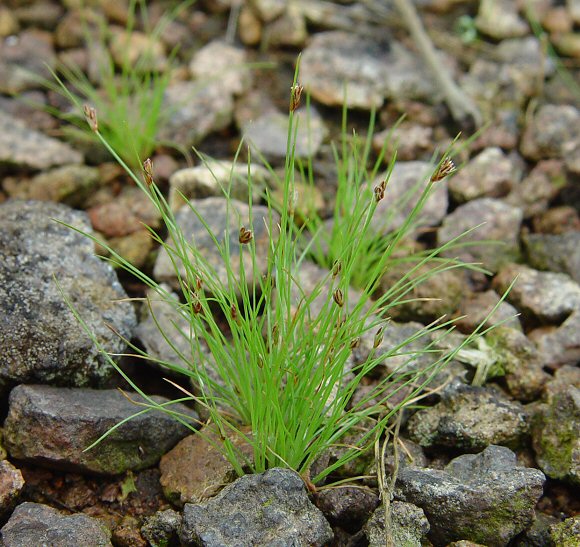Bulbostylis capillaris (L.) Kunth ex C.B. Clarke
Densetuft Hairsedge

Native
CC = 4
CW = 3
MOC = 54
© DETenaglia
Bulbostylis capillaris (L.) Kunth ex C.B. ClarkeDensetuft Hairsedge | |
 |
Native CC = 4 CW = 3 MOC = 54 |
© DETenaglia |
|
Family - Cyperaceae Habit - Annual, tufted sedge.
Stems - Ascending to erect, usually several per plant, 5-30 cm long, slender, unbranched, strongly ribbed, glabrous. Leaves - Basal and 1-2 along the lower stems. Leaf sheaths with the apices thin, scarious, and with a dense fringe of cobwebby hairs, the ligule absent. Leaf blades 1-11 cm long, less than 0.5 mm wide, spreading to ascending, with usually 5 strongly ridged veins, the margins curled inward, glabrous. Inflorescence - Terminal clusters of 2-9 spikelets, these sessile and/or stalked in umbels, less commonly in headlike clusters or appearing as 1 stalked and 1 sessile spikelet, subtended by 2 to several short, leaflike bracts.
Spikelets - Spikelets 2-5 mm long, lanceolate to narrowly elliptic in outline, the tips pointed, the florets 6-15 or more, several-ranked in an overlapping spiral pattern. Spikelet scales 1.5-2.2 mm long, ovate, keeled, glabrous or minutely hairy, the margins often irregular or with a cobwebby fringe of fine hairs, dark brown to reddish brown, the green midrib often extended into a short mucro at the tip. Florets perfect. Perianth (bristles or scales) absent. Stamens 2. Styles expanded at the base and persisting at the tip of the fruit as a minute, peglike or caplike tubercle, usually dark brown at maturity and separated from it by a line or constriction. Stigmas 3. Ovaries and fruits naked, without a perigynium (saclike covering).
Fruits - Achenes 0.7-1.0 mm long, broadly elliptic to obovate in outline, strongly 3-angled, the surface with horizontal wrinkles, pale yellow to light brown. Flowering - June - October. Habitat - Glades, thin-soiled areas of prairies, rocky openings of dry upland forests, sand prairies, pond margins, roadsides. Usually found on acidic substrates. Origin - Native to the U.S. Lookalikes - Species of Fimbristylis, Eleocharis. Other info. - This little species is fairly common in the southern 2/3 of Missouri, and is also found in scattered form across most of the eastern half of the continental U.S. as well as in areas of the southwest. It is recognized by its habitat, small tufted growth, and terminal spikelets. The plant is quite small and can flower when only a few centimeters tall. Photographs taken on Stegal Mountain, MO., 6-12-03 (DETenaglia); also at Sand Prairie Conservation Area, Scott County, MO, 9-7-2020 (SRTurner). |